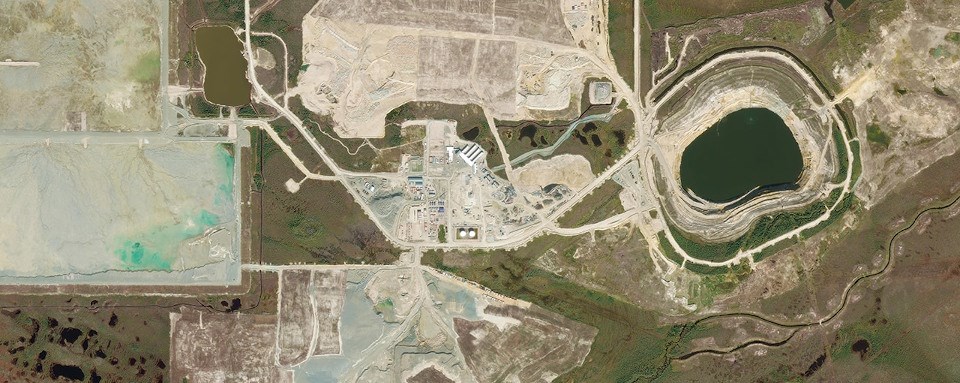A victory in court against De Beers Canada "sets a precedent" on reporting and regulating mining pollution in Ontario's Far North, according to an environmental law organization.
Ecojustice said its "eight-year struggle for accountability" from the global diamond producer came to an end when the company pleaded guilty in a Timmins courtroom last week to one count of failing to provide mercury monitoring data from pollution streaming from its Victor Diamond Mine in the James Bay region.
De Beers Canada operated the open-pit Victor diamond mine, 80 kilometres west of Attawapiskat First Nation, from 2008 to 2019.
According to evidence gathered by Wildlands League, starting in 2015, De Beers continuously failed to report mercury and methylmercury levels in water systems around the Victor Mine site over a seven-year period, "despite being required by law to do so," said Ecojustice in its release.
Methylmercury is a poison that, when in elevated levels of river water, can put humans at risk through the consumption of fish, the group said.
Want to read more stories about business in the North? Subscribe to our newsletter.
Ecojustice said the company pumped water from the Victor pit into the Granny Creek water system, which flows into the Attawapiskat River –upstream from the community – triggering a rise in the mercury levels in the water and fish populations.
Ecojustice said De Beers Canada was required by the provincial government to report mercury monitoring data annually from eight mercury monitoring stations and one control site in the Granny Creek system. These stations are early warning systems for mercury pollution in the river.
The investigation started by Wildlands League revealed De Beers failed to report on five out of nine surface water monitoring stations, a mandatory requirement of its permit.
The release said mercury monitoring data "repeatedly exceeded" U.S. Environmental Protection Agency (EPA) standards for human and wildlife exposure from those stations between 2008 and 2015. De Beers was using EPA standards because Canadian guidelines were not "sufficiently protective" of the environment, according to a 2013 De Beers report referenced by Ecojustice.
De Beers Canada takes issue with Ecojustice's interpretation of events, particularly the accusation that the company polluted the environment.
"Mercury was never used during operations at the mine and is naturally occurring throughout the James Bay lowlands," said the diamond mining company in a July 6 rebuttal.
De Beers claims the mercury monitoring program at Victor is "more rigorous than that of any other mine in Ontario" and all sampling results complied with the mine's government-issued Certificate of Approval (C of A).
"De Beers monitors for mercury and methyl mercury in the surrounding environment and will continue to do so as required by permits and approvals," the company said in a statement.
On June 30, De Beers insists it pleaded guilty to one count, in the Ontario Court of Justice, of not reporting mercury monitoring results in its annual report at its G2 station in 2014 as required under the C of A.
The company insists it was not charged for failing to take samples, monitoring or for polluting the environment.
The company said it's committed to following regulatory compliance "at all times" and that the sample results from that particular monitoring station "were well within" Canadian and provincial water quality guidelines for the Protection of Aquatic Life and complied with the mine's C of A.
That reporting omission was subsequently addressed in the 2015 annual report, which included sample results from the G2 station, but nevertheless, De Beers said, the sampling from that particularly station - located between two other monitoring stations - wouldn't have changed the outcome of their monitoring analysis.
De Beers Canada said all the annual mercury monitoring reports for Victor are publicly available on its website.
Sign up for the Sudbury Mining Solutions weekly newsletter here.
Based on the evidence provided by Trevor Hesselink of Wildlands League, Ecojustice brought a private prosecution against De Beers Canada, in partnership with former prosecutor David Wright.
De Beers added it has amended its annual reporting prior to the private prosecutor laying charges and the Ministry of Environment, Conservation and Parks did not initiate a prosecution against De Beers in relation to this matter.
According to Ecojustice, the terms of the resolution require De Beers to publicize all past and future annual mercury monitoring reports on its website.
The group further said this case sets a precedent for mining activities in the province, including the so-called Ring of Fire area in Northern Ontario, and how mining pollution is to be reported and regulated.
In their release, Ecojustice said the decision puts the Ford government on notice with its plans to press ahead with development of the mineral resources in the nearby Ring of Fire.
“While Premier Doug Ford has oft claimed Ontario is open for business, this prosecution makes clear that any mining activity must still follow the law," said Ecojustice lawyer Zachary Biech in a statement.
“This private prosecution was necessary because Ontario’s reliance on self-reporting by mining companies does not work. Too often, this gives mining companies the opportunity to pollute with impunity, as was the case with DeBeers at its Victor Mine.
“The precedent set by this case will help improve regulatory oversight of future mine projects and should make polluters think twice in the event they are tempted to sidestep their reporting duties.”
Hesselink, Wildlands League's director of policy and research said: "The public was deprived of required monitoring of a known neurotoxin in the water systems around this diamond mine.
“If Ontario’s current system cannot be trusted for a single mine, what liabilities loom ahead for the far more ambitious mining plans in this sensitive ecosystem?
“While transparency and regulatory oversight are clearly needed more than ever, they are sadly backseat to the current ‘red-tape reduction’ priorities of this government.”




